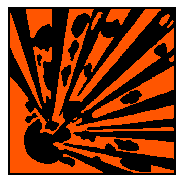International Chemical Safety Cards
| 2,4,6-TRINITROTOLUENE | ICSC: 0967 |
| 2,4,6-TRINITROTOLUENE 2-Methyl-1,3,5-trinitrobenzene alpha-Trinitrotoluol TNT C7H5N3O6/C6H2(CH3)(NO2)3 Molecular mass: 227.1 CAS # 118-96-7 RTECS # XU0175000 ICSC # 0967 UN # 0209 EC # 609-008-00-4 |
 |
 |
| TYPES OF HAZARD/ EXPOSURE |
ACUTE HAZARDS/ SYMPTOMS |
PREVENTION | FIRST AID/ FIRE FIGHTING |
| FIRE | Explosive. |
NO open flames, NO sparks,
and NO smoking. |
Water in large amounts. Do
not attempt to extinguish large fire, evacuate area. |
| EXPLOSION | Risk of fire and explosion
upon rapid heating or strong shock. |
Do NOT expose to friction
or shock. Do not expose to heat. |
In case of fire: keep
drums, etc., cool by spraying with water. Combat fire from a sheltered position. |
| EXPOSURE | |
STRICT HYGIENE! |
IN ALL CASES CONSULT A
DOCTOR! |
| INHALATION | Abdominal cramps. Blue
lips or finger nails. Blue skin. Cough. Headache. Laboured breathing. Vomiting. Symptoms
may be delayed (see Notes). |
Local exhaust or breathing
protection. |
Fresh air, rest. Artificial
respiration if indicated. Refer for medical attention. |
| SKIN | MAY BE ABSORBED! Redness.
Pain (further see Inhalation). |
Protective gloves.
Protective clothing. |
Remove contaminated
clothes. Rinse and then wash skin with water and soap. Refer for medical attention. Wear
protective gloves when administering first aid. |
| EYES | Redness. Pain. |
Face shield or eye
protection in combination with breathing protection. |
First rinse with plenty of
water for several minutes (remove contact lenses if easily possible), then take to a
doctor. |
| INGESTION | (further see Inhalation). |
Do not eat, drink, or smoke
during work. |
Rinse mouth. Induce
vomiting (ONLY IN CONSCIOUS PERSONS!). Wear protective gloves when inducing vomiting. |
| SPILLAGE DISPOSAL | STORAGE | PACKAGING & LABELLING | ||
| Evacuate danger area!
Consult an expert! Wet spilled material before picking it up, do not attempt to sweep up
dry material. Do NOT wash away into sewer. Sweep spilled substance into containers.
Carefully collect remainder, then remove to safe place. Do NOT let this chemical enter the
environment (extra personal protection: self-contained breathing apparatus). |
Fireproof. Separated from
combustible and reducing substances, heavy metals and initiator explosives. Tightly
closed. Cool. Dry. |
Unbreakable packaging; put
breakable packaging into closed unbreakable container. E symbol T symbol R: 2-23/24/25-33 S: 35-44 UN Hazard Class: 1.1D |
||
| SEE IMPORTANT INFORMATION ON BACK | ||||
|
||||